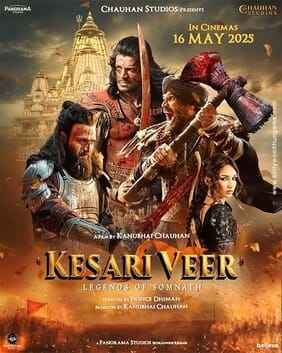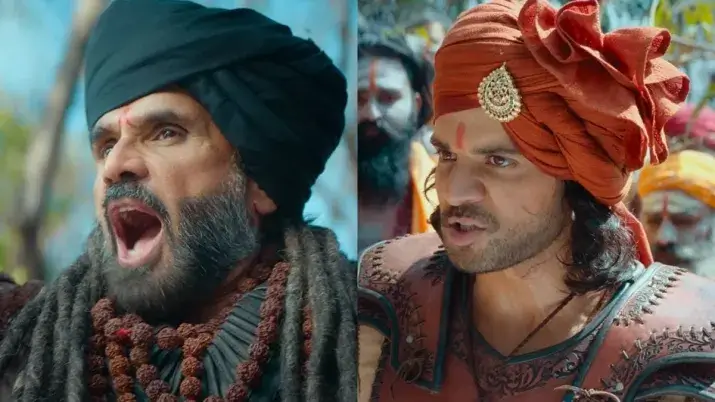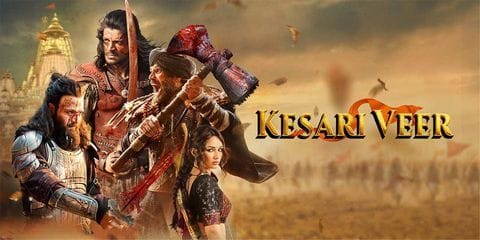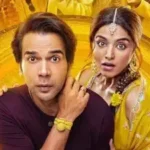Kesari Veer, the newest addition to the genre of patriotic historical dramas, seeks to tell the story of Hamirji Gohil, a Rajput warrior from the 14th century celebrated for defending the Somnath Temple against the Tughlaq empire.
The film arrives with grand aspirations — a star-studded cast, stylized action, and a spirit of patriotism — but regrettably becomes hindered by excessive storytelling, exaggerated visuals, and variable performances.
Although the intention is commendable, the execution falls short of expectations.
Plot Summary
Taking place in the 14th century, Kesari Veer focuses on the brave warrior Hamirji Gohil, played by Sooraj Pancholi, who gives his life to uphold the sanctity of the Somnath temple.
The film dramatizes his resistance against the invading Tughlaq forces, interweaving historical facts with fictionalized elements.
Suniel Shetty portrays a devout elder warrior and mentor to Hamirji, while Vivek Oberoi takes on the role of the antagonist representing the Tughlaq side.
Akanksha Sharma plays the female lead, although her character primarily serves emotional purposes and has a superficial presence on-screen.

Direction and Screenplay
Directed by Prince Dhiman and Kanubhai Chauhan, the film strives to present an epic narrative, but it suffers from erratic pacing and excessive melodrama.
The screenplay struggles to maintain a cohesive direction, jumping between dramatic set pieces without sufficient depth or clarity.
The rich historical backdrop holds significant promise but is not fully realized.
The dialogues fluctuate between overly grand patriotism and clumsy exposition.
While Kanubhai Chauhan’s writing exhibits ambition, it lacks the refinement required for effective historical storytelling.
Performances
Sooraj Pancholi, as Hamirji Gohil, puts forth his best effort to embody a fierce, valiant warrior.
Although his physical presence suits the character, his emotional range appears limited, particularly in scenes that require subtlety.
Some of his action scenes are praiseworthy, yet the character’s dramatic impact does not consistently resonate.
Suniel Shetty adds a touch of dignity and seriousness to his role.
As an elder warrior mentoring Hamirji, his performance stands out as one of the more grounded elements of the film.
Shetty’s screen presence and vocal delivery fit well, though his character’s development remains insufficiently explored.
Vivek Oberoi fully embraces his role as the antagonist, but his performance often veers into theatricality, bordering on the exaggerated.
His depiction lacks the menace and depth one would anticipate from a well-crafted villain.
Akanksha Sharma primarily occupies a secondary role, contributing little to the storyline aside from a few emotional moments.

Visuals and VFX
One of the widely criticized elements of Kesari Veer is its visual presentation.
While Vikas Joshi’s cinematography captures the majesty of forts and battle scenes, the excessive reliance on flashy visual effects undermines the film’s authenticity.
Certain moments, such as a battle where a beheaded warrior continues to fight, feel more aligned with video games than a historical drama.
The color grading heavily leans towards saffron tones, possibly reflecting the title and theme of bravery and sacrifice, but soon becomes visually overwhelming.
The overall visual aesthetic appears too loud and artificial for a narrative that could have thrived on a more realistic and grounded portrayal.
Editing and Pacing
Edited by Satya Sharma, the film contains instances where the narrative flow appears abrupt and disconnected.
The pacing varies significantly — certain scenes drag on excessively while key plot developments seem hurried.
A more concise edit could have improved engagement, particularly during the lengthy war sequences.
Music and Sound Design
Monty Sharma’s score is loud and dramatic, intended to enhance the emotional impact but often comes across as monotonous.
The film’s music aims to evoke patriotic feelings, yet it lacks memorable melodies or themes that might resonate after viewing.
The sound design is also over-the-top, with battle scenes frequently overwhelmed by a cacophony of clashing swords, echoing screams, and intense orchestral elements that obscure dialogue.
Historical Accuracy vs. Cinematic Liberty
A significant flaw in Kesari Veer is its artistic license.
While inspired by a true historical figure, the film often blurs the distinction between myth and reality, frequently without adequate context.
The desire to glorify heroism is understandable, but the lack of historical depth renders the film more akin to a fantasy epic than a biographical narrative.
A more research-oriented approach could have made the story both educational and emotionally engaging.
Unfortunately, the emphasis appears to be on visual spectacle rather than historical accuracy.
Themes and Symbolism
Kesari Veer heavily emphasizes nationalism and sacrifice. Ideas of loyalty, duty, and dharma are consistently highlighted.
There’s a strong inclination toward fostering cultural pride, particularly through symbolic associations with saffron — recognized as the color of valor in Indian culture.
However, the excessive reliance on patriotic dialogue and saffron-themed imagery comes across more as messaging rather than storytelling.
The film strives to invoke national pride but often falls back on clichés instead of developing a truly inspiring narrative.
Final Verdict
Kesari Veer possesses all the elements for an epic — a brave historical hero, a tale of sacrifice, a renowned cast, and a substantial budget.
Sadly, it misuses its potential through exaggerated performances, excessive visual effects, a weak screenplay, and a lack of historical authenticity.
While fans of patriotic films may find some moments to celebrate, general viewers seeking a compelling historical drama might leave feeling underwhelmed.
Rating: 2.5/5
Pros:
Suniel Shetty’s dignified portrayal
Strong premise rooted in historical valor
Some commendably executed action scenes
Cons:
Weak writing and inconsistent storytelling
Overabundance of visual effects that overshadow the plot
Exaggerated performances and clichéd dialogue
Absence of emotional depth or historical precision
Conclusion
Kesari Veer serves as a prime example of style overshadowing substance.
It strives to convey an inspiring account of courage and sacrifice but is burdened by a loud presentation and uninspired writing.
With a more refined script, subdued visuals, and a greater emphasis on authentic storytelling, it could have transformed into a memorable homage to a forgotten warrior.
Instead, it stands as an ambitious yet flawed spectacle.
Release Date: 23 May 2025
Language: Hindi
Genre: Historical Action Drama
Directed by: Prince Dhiman & Kanubhai Chauhan
Written by: Kanubhai Chauhan & Shitiz Srivastava
Produced by: Rajen Chauhan, Heena Chauhan, Suhraj Chauhan, Ohm Chauhan
Cinematography: Vikas Joshi
Editing: Satya Sharma
Music: Monty Sharma
Production House: Chauhan Studios
Distributor: Panorama Studios
Cast: Suniel Shetty, Sooraj Pancholi, Vivek Oberoi, Akanksha Sharma
Budget: ₹60 crore
Do check out: Bhool Chuk Maaf Movie review








